Resolving Varnish Challenges Using Soluble Varnish Removal Technology
Abstract
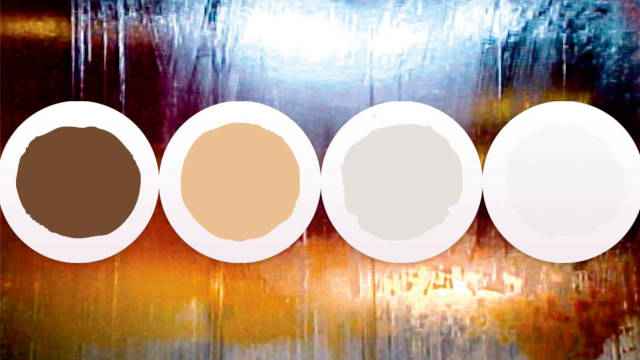 Varnish is an organic residue produced by the irreversible chemical degradation of lubricants, and it leads to numerous equipment problems, including:
Varnish is an organic residue produced by the irreversible chemical degradation of lubricants, and it leads to numerous equipment problems, including:
- Filter plugging
- Restricted oil flow
- Poor heat transfer
- Valve sticking
- Fail-to-start conditions
- Costly unit trips
Varnish has traditionally been defined as an insoluble deposit, but it also exists in a soluble state, and the conversion between soluble and insoluble is a physical equilibrium process dependent upon temperature. The soluble varnish becomes insoluble by reducing the lube oil temperature; therefore, it is critical to remove soluble varnish from lube oil to permanently resolve varnish-related issues.
Due to the prevalence and costly nature of varnish-related failures, strategies have been developed to mitigate the effects of varnishing. The most important aspect is to routinely measure the varnish, develop a trend, and use suitable technologies to remove it from the lube oil system.
This paper describes a technical evaluation of the effectiveness of ion charge bonding technologies in removing soluble varnish and the technology’s potentially negative effects on lube oil additives.
The evaluation conducted onsite field tests on a gas turbine and was followed by a laboratory assessment. To measure the effectiveness of the technology, lube oil samples were tested for:
- MPC
- RULER
- TAN
- Particle Count
- Other primary oil parameters
Introduction

Varnish is widely accepted as one of the industry’s major lubrication challenges. During rotating equipment operation, friction generates heat which degrades the oil and produces degraded by-products – varnish. As varnish accumulates, the rotating equipment’s performance suffers immensely. Furthermore, with enough time, varnish deposits can thermally cure on surfaces, creating a solid coating that is difficult to remove and increases the risk of failure.
At Saudi Aramco, lube oil degradation and varnish are the leading causes of lubrication failure in our critical rotating machines, which can have devastating consequences. In oil and gas companies, gas turbine shutdowns due to varnish formations can cost up to $150,000 per incident.
Therefore, removing varnish from lube oils is essential for preventing catastrophic failure, major operational losses, and expensive equipment repairs. In response to this need, a variety of varnish removal technologies have been developed and are now readily available. Many of these systems are not only adept at removing both soluble and insoluble varnish, but at improving heat dissipation rates and reducing system temperatures, preventing future varnish formation.
Varnish Formation
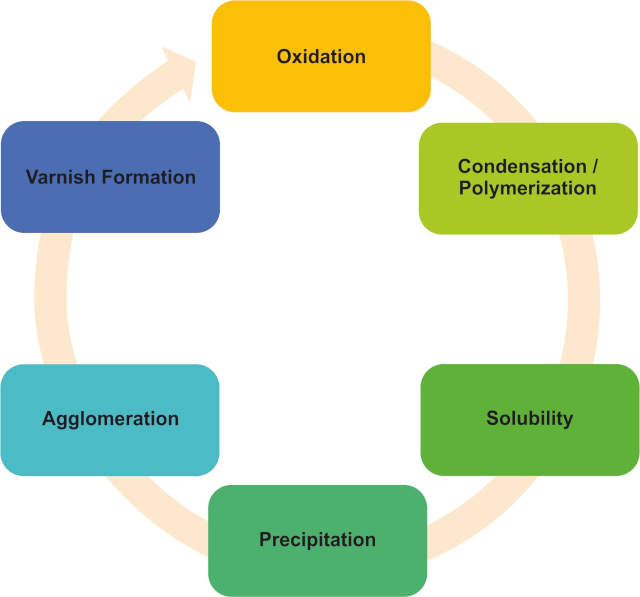
Under normal operating conditions, lube oils are subjected to oxidation, but as modern equipment continues to demand more from their lube oils, thermal stress is increasing. This equipment is subjected to micro-dieseling and static electricity discharge, which accelerate the lube oil’s oxidation process. This oxidation degradation produces polar molecules from non-polar mineral oils. These polar species represent the starting point of the varnish life cycle.
Currently, the industry is trending toward using highly refined lube oils, which have higher oxidation and thermal stability, but low solvency characteristics compared to conventional lube oils. The polar oxidative by-products become larger due to polymerization. As the polar oxidative by-product comes out of the solution, they agglomerate and collect on bi-polar metal surfaces, which attract polar oxidative molecules and form a sticky deposit. Varnish typically forms in relatively cool zones with low flow and clearances, like valve spools and oil reservoirs, because they have relatively low solubility.
The major causes of varnish formation are:
- Static electricity discharge from mechanical filters
- Shared reservoir for hydraulic and lube oil circuit
- Hot spot in the system
- Additive depletion
- Implosion of air bubbles (micro-dieseling)
- Low-flow hydraulic circuits with temperature differentials
Varnish can impact equipment operation in several ways:
- Accelerates the oil degradation process.
- Reduces clearance in spools and bearings due to deposit formation. Deposits cause valve sticking and equipment malfunctions.
- Attracts contaminants and increases bearing wear.
- Reduces the performance of heat exchangers.
- Causes filter plugging.
- Reduces heat dissipation and increases oil and application temperatures.
Saturation, Equilibrium, and the Varnish Life Cycle
Varnish’s solubility in lube oil is temperature dependent, and the lube oil has a finite ability to dissolve soluble varnish at any given temperature. The oil’s saturation point increases with raised temperatures and decreases with lower temperatures. Lubricant saturation and thermal symmetries play key roles in the varnish life cycle.

During service, lubricants chemically degrade in an irreversible manner, producing soluble varnish, which accumulates in the solution (Step 1).
As soluble varnish builds up, the lubricant eventually reaches its saturation point. Beyond this point, any additional vanish produced will be insoluble. Continued degradation of a saturated lubricant produces insoluble varnish particles (Step 2). These particles eventually agglomerate and produce deposits (Step 3).
Phase changes between soluble and insoluble varnish are physical in nature, therefore, they are reversible. Because the levels of varnish are dependent on temperature, once the varnish is deposited, conditions can be altered to positively shift the equilibrium and return the deposits to a dissolved soluble state. This ability to manipulate the equilibrium is key to completely removing varnish and mitigating the risks associated with it.
The majority of lubricant breakdown events occur in the hottest areas of a system, known as “hot spots”. The high temperatures in these hot spots warm the lubricant and increase its capacity to dissolve soluble varnish. As the lubricant varnish solution cools in other areas, the oil’s saturation point decreases. Although the lubricant can accommodate the present soluble varnish levels when warm, these levels often exceed the lubricant’s capacity in cooler areas.
When a fluid’s concentration of soluble varnish exceeds its saturation point, the lubricant becomes supersaturated; soluble varnish will convert to insoluble varnish and deposits until it drops to levels that can be accommodated at that specific temperature. If nothing is done to address the levels of soluble varnish present at lubricant operating temperatures, the varnish will continue to precipitate and deposit in cooler regions.
Varnish Removal Technologies
Soft contaminants within the oil’s equilibrium state tend to be submicron in size and are often both soluble and insoluble. They can be difficult to extract due to the high operating temperature of many in-service lubricants, which can cause them to change into a soluble state.
There are currently several filtration and separation technologies on the market that can intervene with the formation of varnish. By continually removing harmful degradation by-products, the concentration of varnish precursors is reduced, providing a cleaner working oil.
Balance Charge Agglomeration

The balance charge agglomeration (BCA) technology divides the fluid into two streams and charges the contaminant particles with oppositive charges – positive (+) and negative (-). These charge particulates are recombined and mixed under a turbulent flow to form larger, neutral particles, which can be removed with traditional mechanical filtration devices.
Electrostatic Liquid Cleaner
The electrostatic liquid cleaner (ELC) system operates on the basic principle that opposite charges attract. With the help of a constant electric field, a positively charged particle is drawn toward a negative electrode within the system, and particles with an inherent negative charge are drawn toward a grounded plate. Polar contaminants (molecules having a non-uniform charge distribution – a main component of varnish) are drawn to the area of the greatest field strength of the collector media.
Electrostatic Separation Process

The electrostatic separation process (ESP) is the physical and/or chemical binding of atoms, molecules, or particles to a surface. The filtration process is comprised of adsorption and chemisorption. The media is designed to remove certain chemistries from the fluid without impacting healthy additive components.
This technology is advantageous because it removes selected degradation products regardless of if they are in suspension or in solution. Because of its chemical structure, varnish molecules are believed to be attracted to the adsorbent through weak molecular forces such as Van der Waals (or dispersion) and hydrogen bonding.
Varnish Removal by Adsorption
Adsorption is the selective physical and/or chemical binding of atoms, molecules, and particles to a surface – or adsorbent – such as activated carbon or silica gel. It is not the same as absorption; absorption is not selective and takes material into the absorbent material like a sponge does with water.
A major distinction between classical adsorption and filtration systems as a processing element is that the performance of the adsorber typically depends on temperature, flow rate, concentration, and other operating conditions, while filters are less sensitive to such conditions.
Some high-quality oil filters utilize cellulose, which can be used as an adsorbent. It has a high surface area, and due to its chemical nature, the fibers are well-suited to pick up oxygenated organic molecules such as varnish.
Chemical Cleaning
Chemical cleaning involves using chemicals to clean the lube oil system internally. The equipment is switched off, and the lube oil is drained out of the system. Certain chemicals are then used to flush the system to remove any varnish deposits from the internal surfaces. This is considered an effective method for removing internal varnish deposits, however, because the equipment has to be offline during cleaning, it can usually only be done during Test and Inspection (T&I) or planned outages.
Principle of Soluble Varnish Removal Technology

The soluble varnish removal technology will be connected to the lube oil tank in the form of a “kidney loop”. The hot oil is drawn from the lowest point of the system tank to the soluble varnish removal technology through a transfer pump on the unit.
This filtration medium is a composite consisting of a cellulose fiber matrix and other materials that give it a high-void volume and open-fiber matrix. The resin-bonded, open-fiber matrix provides high permeability, which is necessary for the fluid to contact the large fiber surface area and for the varnish precursors to be absorbed. These specially formulated binder resins give the filter media a high affinity for the polar varnish precursors, resulting in high removal efficiency and retention of the material suspended in the fluid phase.
Selective ion exchange resins are mixed and formulated to absorb varnish within their porous structure. This absorptive nature is due to the polar attraction between ion exchange resignation and varnish contamination. There are large amounts of surface area by volume, making this process highly effective.
Soluble varnish removal systems use a specialized ion charge bonding media that contains billions of sites capable of adsorbing soluble varnish. This adsorption relies on a preferential interaction between the varnish molecules and the sites present within the media.
Soluble varnish removal systems interrupt the varnish life cycle at its earliest stage and prevent soluble varnish from accumulating in the lubricant and forming harmful varnish particles and/or deposits. Since the soluble contaminants that they remove are prevalent at operating temperatures, these systems are also suited for continuous use during turbine operation.
When the soluble varnish is continuously removed, the levels present remain well below the lubricant’s saturation point. This means that the risk of having varnish deposits in cooler areas or during shutdowns is effectively eliminated.
While the competing particulate removal systems are unable to remove both the soluble and insoluble varnish, soluble varnish removal systems exploit the equilibrium that exists between these two phases to remove all varnish. This includes not only the varnish present in the lubricant but also the varnish which may have previously been deposited on equipment surfaces.
Piloting Methodology
This soluble varnish removal technology with a flow rate of 7.5 gallons per minute (GPM) was evaluated in collaboration with Saudi Aramco, where it was piloted on a M58-CGTG-07 Gas Turbine lubricant reservoir. The reservoir capacity was 1700 USG, and the machine was running with Gas Turbine Oil 32. The turbine was selected due to its high MPC (varnish potential) – a value of 35 – which was confirmed by a sample analysis report, seen in Figure 7.

The soluble varnish removal system was installed on the lube oil reservoir for a period of roughly three months. Samples were taken from the device’s outlet to test its effectiveness.
Evaluation Methods
The evaluation of the soluble varnish removal technology was carried out both in the lab and field to assess its effectiveness at removing varnish from the in-service lube oil.
The following analyses were performed to assess the condition of the gas turbine oils in service at CGTG-07.
- Varnish Potential by Membrane Patch Colorimetry (MPC): ASTM D7843.
- Acid Number (AN): ASTM D664.
- Oxidation by Fourier Transform Infrared (FTIR) Spectroscopy: ASTM E2412.
- RULER Antioxidant Additive Testing: ASTM D6971.
- Dissolved Metals: ASTM D5185.
- ISO Particle Count: ISO 11500 and ISO 4406.
Laboratory-scale soluble varnish removal columns were then prepared to assess the effectiveness of the fluid treatment using ion charge bonding media. A portion of each provided oil sample was then passed through the separate columns for 24 hours at a rate of 20 mL/minute and a temperature of 40°C. Following soluble varnish removal treatment, the analyses listed above were repeated, and their results were used to assess soluble varnish removal effectiveness in a lab.
Lab Evaluation Result
In total, Saudi Aramco submitted one fresh and one used Gas Turbine Oil 32 sample collected from the CGTG-07 Gas Turbine to the lab to determine the condition of the in-service lube oil and assess the effectiveness of the soluble varnish removal technology.
The results of the lab assessment are shown below:
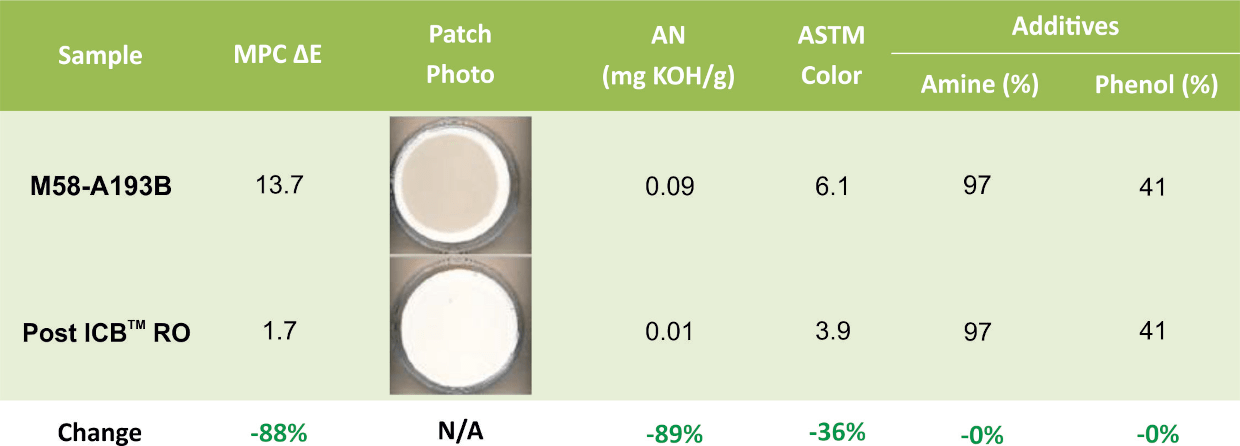
The used oil’s MPC suggested that varnish would become a serious problem in the near future. Fortunately, ion charge bonding efficiently removed the accumulated varnish, and the oil’s MPC ΔE decreased by 88% following lab-scale soluble varnish removal treatment.
With these dramatically reduced MPC values, the risks associated with varnishing were mitigated. In addition, since the soluble and insoluble varnishes deposited within a system exist in equilibrium with one another, the removal of soluble varnish would prompt previously deposited varnish to re-dissolve. Once re-dissolved, the soluble varnish removal technology would remove this varnish as well.
These findings were corroborated by color and acid number analyses, which showed a 36% and 89% decrease in varnish precursor levels, respectively, and the fluid’s acid number was brought down to better-than-new oil levels. These results highlight that the filter media not only already-present varnish, but also key varnish feedstocks.
Since varnish removal filtration occurs continuously, these varnish precursors can be removed as they form, completely preventing varnish problems.
Finally, because the filter media is engineered to leave desirable additives untouched, no additive loss was observed with the in-service Gas Turbine Oil 32.
Field Evaluation
The final sample taken before completing the trial revealed that:
- The acid number, moisture content, and viscosity levels were all within the desired target range.
- The fluid’s ISO particle count had decreased from 20/18/12 to 15/12/9.
- The MPC ΔE was now <15, indicating a low level of degradation by-products within the fluid.
- While silicon levels were above target and phosphorus levels were below, all other dissolved metals were within the target range.
- The fluid’s color level was above target.
- 100% of the oil’s amine and 100% of the oil’s phenol antioxidants remained similar to samples tested during installation, indicating there was no impact to the additives system in the lube oil.
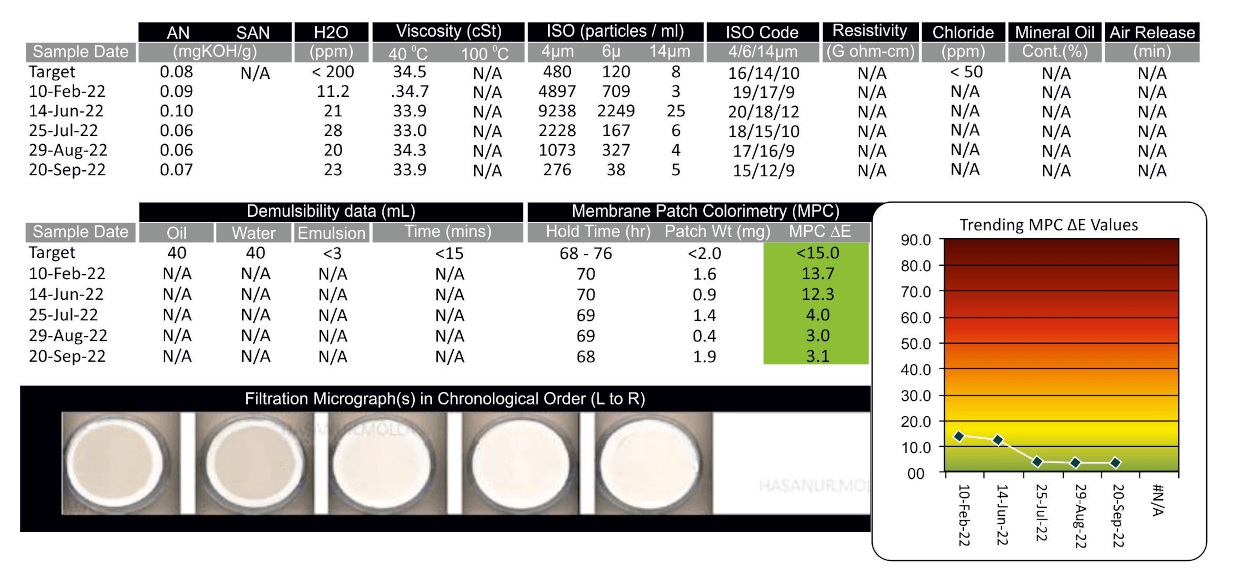
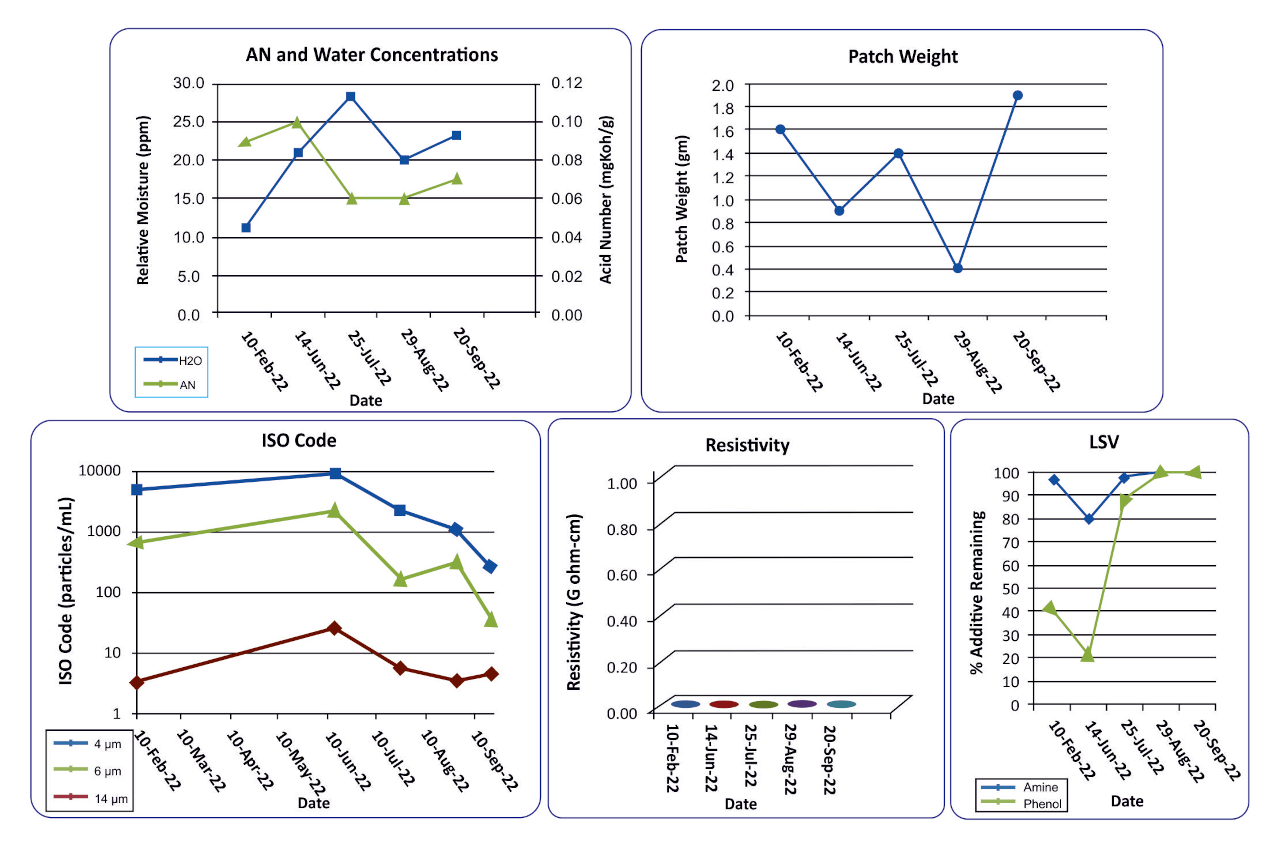
Note: This trial took place under controlled conditions. The results may vary depending on the unit condition and performance and the quality of the lube oil.
Conclusion
The application of a soluble varnish removal technology facilitated improvements to oil cleanliness by effectively removing soluble and insoluble varnish from the lube oil system. In addition to improving equipment reliability, it eliminated the need for immediate premature lube oil replacement, system flushing, and chemical cleaning.
References
- “Lubricant Varnishing and Varnish Mitigation” by M. G. Hobbs & P. T. Dufresne Jr. from EPT, published at LUBMAT 2014, Manchester, UK.
- “The Root Cause of Varnish Formation” by Buddy Atherton, Technical Sales Manager, United Air Specialists, Inc. / Kleentek
- “Sludge and Varnish in Turbine Systems” by Jim Fitch from Noria Corporation, published at Machinery Lubrication, USA
